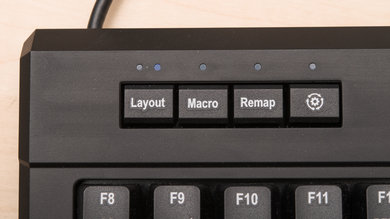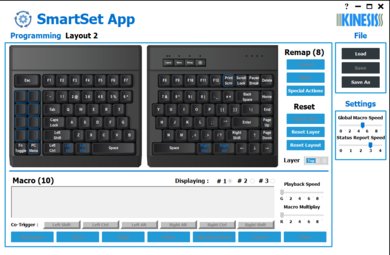The Kinesis Freestyle Pro is an ergonomic split keyboard with a good overall typing experience, although it can take a bit of time to get used to its design. This keyboard features Cherry MX Brown switches, which give you a tactile bump right before the actuation of the key. Unfortunately, although this is an ergonomic keyboard, it doesn't have any tilt settings or a wrist rest, which must be purchased separately at extra cost.
Our Verdict
The Kinesis Freestyle Pro is a satisfactory gaming keyboard. It features Cherry MX Brown switches with low actuation force and pre-travel distance. It feels rather responsive, but the keycaps might disappoint a few people. You can also only use the left half of the keyboard, giving you more room for your mouse. Unfortunately, it has no backlighting and might not be ideal for gaming in a dark room.
-
Good ergonomic design.
-
Many keybinding options.
-
Can be used on Windows, macOS, and Linux.
-
Cheap plastic build.
-
No backlighting.
The Kinesis Freestyle Pro isn't designed to work with mobile devices and tablets.
The Kinesis Freestyle Pro is a good office keyboard thanks to its ergonomic design. You can set it up the way you prefer and it provides a great typing quality, although it might take you some time to get used to the split keyboard design. Although it has good ergonomics, it doesn't come with some accessories like wrist rests and incline settings, which need to be purchased separately, at extra cost.
-
Good ergonomic design.
-
Many keybinding options.
-
Can be used on Windows, macOS, and Linux.
-
Cheap plastic build.
-
No backlighting.
The Kinesis Freestyle Pro is a decent programming keyboard but might take some time getting used to due to its split design. Its Cherry MX Brown switches provide good feedback without being too noisy, which offers an overall great typing quality. However, its keycaps feel a bit cheap and it also doesn't have any backlight. On the upside, it's fully compatible on Windows, macOS, and Linux.
-
Good ergonomic design.
-
Many keybinding options.
-
Can be used on Windows, macOS, and Linux.
-
Cheap plastic build.
-
No backlighting.
-
Good ergonomic design.
-
Many keybinding options.
-
Can be used on Windows, macOS, and Linux.
-
Cheap plastic build.
-
No backlighting.
- 7.4 Gaming
- 3.2 Mobile/Tablet
- 7.8 Office
- 6.7 Programming
- 3.6 Entertainment / HTPC
Changelog
- Updated Mar 06, 2024: We've added details to the Ergonomics section of this review about the tenting kit and palm rest accessories that Kinesis sells for this keyboard separately.
- Updated Nov 01, 2021: Converted to Test Bench 1.0.
- Updated Jan 20, 2020: Review published.
Check Price
Differences Between Sizes And Variants
There's also a model variant that has MX Silent Red switches, but we tested the one with Cherry MX Brown switches, which provides a tactile bump, but without the clicky noise of blue switches.
Compared To Other Keyboards
The Kinesis FreeStyle Pro is a good mechanical keyboard with a split design. However, its ergonomics aren't as good as other similar keyboards like the ErgoDox EZ, as it lacks incline settings and doesn't come with a wrist rest. For more options, check out our recommendations for the best gaming keyboards, the best ergonomic keyboards, and the best mechanical keyboards.
The Kinesis Freestyle Pro is a very different ergonomic keyboard than the Logitech ERGO K860. The Logitech features a curved board design, while the Kinesis is a fully split keyboard. The Logitech features scissor switches, while the Kinesis has Cherry MX Brown mechanical switches. Also, the Logitech is a full-size board, while the Kinesis is a TKL 80%. The Logitech is wireless, and the Kinesis is wired-only.
The ErgoDox EZ is a better ergonomic keyboard than the Kinesis Freestyle Pro. It feels better built, has a wider switch variety, and has incredible ergonomics. However, it might be noticeably harder to get used to than the Kinesis.
The Kinesis Freestyle Pro is significantly better than the Microsoft Sculpt Ergonomic Keyboard. The Freestyle Pro has a much better build quality, typing experience, and better software support. It also has better compatibility with different operating systems, but the Sculpt Ergonomic is much more comfortable to type on due to its dome design and its reverse incline that relieves pressure on the wrists.
The Logitech K350 and the Kinesis Freestyle Pro are very different ergonomic keyboards. The Logitech has a slightly curved design, while the Kinesis features two halves that you can place however you prefer. On the other hand, the Logitech has rubber dome switches that feel very heavy and provide a much less satisfactory typing experience than the mechanical switches of the Kinesis.
The Kinesis Freestyle Edge RGB is better than the Kinesis Freestyle Pro. The Edge comes with a wrist rest, RGB lighting, and an ever-so-slightly better build quality. If you're simply looking for an office keyboard, go for the Freestyle Pro, but if you game for long periods, especially at night, the Edge RGB is the better option.
The Kinesis Freestyle Pro is a much better keyboard than the Adesso Tru-Form 150. It's smaller, so it takes up less space on your desk, but the typing quality is far superior. The Kinesis also has a dedicated software with macro programmable keys. However, it doesn't have any backlighting, unlike the Adesso, if you need to use it in a dark environment.
The Kinesis Freestyle Pro is a better overall keyboard than the Matias Ergo Pro, although the Matias is a bit superior for office use. It has a wrist rest and incline settings, plus the build quality is also better. However, the Kinesis has full compatibility on Windows, macOS, and Linux systems with dedicated software with a few customization options.
The Kinesis Freestyle Pro is a bit better than the Microsoft Surface Ergonomic Keyboard. The Freestyle Pro's split keyboard design lets you place the two halves any way you want, but the Surface Ergonomic is more comfortable due to its great Alcantara wrist rest. The Freestyle Pro has mechanical Cherry MX Brown switches, programmable keys, and software support; however, the Surface Ergonomic has significantly better build quality.
The Kensington Pro Fit Ergo Wireless Keyboard is very different than the Kinesis Freestyle Pro. It features a curved board with a split-key layout, while the Kinesis' board is separated into two halves that you can place how you want. The Kinesis also uses mechanical switches, which feel more pleasant to type on than the rubber domes of the Kensington. The Kinesis also feels a bit better-built, but office workers might not like the fact it doesn't have a NumPad.
The Dygma Raise is much better than the Kinesis Freestyle Pro for most uses. The Dygma is better in almost every aspect, and it's a lot more customizable, but the Kinesis has better software support, and you can program macros or remap keys directly on the keyboard, which some people may prefer to using software.
The MoErgo Glove80 and the Kinesis Freestyle Pro are split ergonomic keyboards. The MoErgo is a wireless model that connects via Bluetooth and can pair with up to four devices simultaneously. It has more comprehensive ergonomic features, including a concave key well design and tenting angle adjustments. Additionally, it has considerably lower latency, is much more lightweight, and has full RGB backlighting, which the Kinesis lacks. On the other hand, the Kinesis is a wired-only model. By default, it doesn't provide tenting angle adjustment like the MoErgo Glove80, but Kinesis does sell a 'lift kit' separately.
Test Results
This keyboard is rather large and due to its split design, it can take even more space than a typical keyboard. The maximum length of the cable between both parts is about 20 inches (50.8cm).
The Kinesis Freestyle Pro is well-built but feels a bit cheap when using it. The chassis is made from very stiff plastic that feels fairly durable, but the pad printed ABS keycaps feel very cheap and unstable when typing. The cables are also thin; they don't feel very solid and have white markings on them, making them look quite cheap. If you want a keyboard with a better build quality, check out the Dygma Raise.
This split keyboard has an ergonomic design but can take some time to get used to. Also, in its stock configuration, it doesn't have any incline settings or a wrist rest like the Matias Ergo Pro, which is disappointing. That said, Kinesis does offer accessories for additional purchase, including palm rests and a tenting kit that provides incline angle options at 5, 10, and 15 degrees. You can see these accessory options on the Kinesis website here.
In its default configuration without these additional accessories, the keyboard is tilted to the back, making it quite uncomfortable for the wrists, especially during long periods of typing. If you're interested in a keyboard with better overall ergonomic support out of the box, check out our review for the split ErgoDox EZ. If you're interested in an alternative without a split board design, check out the curved Logitech K860.
This keyboard doesn't have any backlighting, but if you're looking for a split design keyboard with backlighting, check out the very similar Kinesis Freestyle Edge RGB or even the cheaper Adesso Tru-Form 150.
The cables are thin and don't feel very durable. There's also a cable linking both keyboard halves. It's 20 inches long (50.8cm), but the default separation is about 12 inches (30cm). If you want to increase it further, you can open up the cable compartment cover and thread the cable to your desired length.
The Kinesis Freestyle Pro is wired-only and can't be used wirelessly.
This keyboard has good extra features. You can use the 'fn' key to access the media keys and can program every key inside the software.
The Kinesis Freestyle Pro has mechanical Cherry MX Brown switches that have a tactile bump right before their actuation point. There's also a model variant that has MX Silent Red switches.
The Cherry MX Brown switches have a nice tactile bump which gives a general good typing quality and feedback, but the ABS keycaps mixed with the cheap feeling of the board give off an unsatisfactory sound when typing. The alphanumerical keys also seem to be slightly unstable, but this isn't too noticeable and shouldn't impact typing that much.
The typing noise is fairly quiet and shouldn't bother the people surrounding you.
The SmartSet software allows a lot of different key customization. You can have up to nine different profiles and create two layouts per profile, giving you a total of 18 different keybinding options. You can also access the software using the keyboard.
Since the software is available on Windows, macOS, and Linux, you can use the Kinesis Freestyle Pro on pretty much every computer and customize it to your preference. However, since it's not wireless, you won't be able to use it with mobile devices.
Comments
Kinesis Freestyle Pro: Main Discussion
Let us know why you want us to review the product here, or encourage others to vote for this product.
Update: We’ve added details to the Ergonomics section of this review about the tenting kit and palm rest accessories that Kinesis sells for this keyboard separately.
- 21010
The Kinesis Pro has optional tenting kit and palm rests for those that want those features. Shouldn’t that at least be mentioned in the ergonomic rating, as you comment that this is missing compared to other keyboards in the same class? It still may not be a good value given the construction, of course.
Hi DkinIA,
Thanks for pointing this out; you’re absolutely right. We plan on adding mention of the option tenting kit and palm rests into this review later this week.
Thanks for your suggestion and best wishes.
- 32120
The Kinesis Pro has optional tenting kit and palm rests for those that want those features. Shouldn’t that at least be mentioned in the ergonomic rating, as you comment that this is missing compared to other keyboards in the same class? It still may not be a good value given the construction, of course.






























